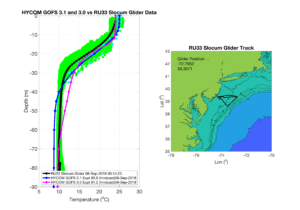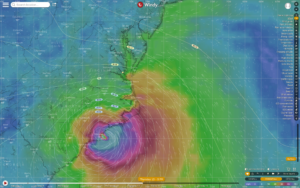-
Glider RU33 Comparison to GOFS 3.0 & 3.1
Posted on September 9th, 2018 No commentsHere are the first model-data comparisons for the hurricane gliders and the operational models produced by our IOOS hurricane post-doc Maria Aristizabal. Maria just started this past week and is harvesting glider data from the IOOS Glider DAC to compare to the operational models.
Our plan was to start with the Navy gliders in the Caribbean, but Florence changed those plans. We’ll turn to Isaac and the Caribbean as we spin up this up with Florence. We are harvesting the glider data from the DAC because we can get IOOS gliders, Navy gliders, OOI gliders and others all in this one place in one format. And we will be adding more operational models, focused on Copernicus Mercator next to compare to the European global model.

Our first comparisons focus on the vertical structure, comparing a day’s worth of glider data (green) and the daily average glider profile (black) with the operational HYCOM initialized with GOFS 3.0 and GOFS 3.1.
We chose glider RU33 for the first comparisons since it is the IOOS glider closest to Florence. The three plots are for Aug 6, 7 & 8 as RU33 approaches the shelf break.
On the shelf the differences between GOFS 3.0 & 3.1 are bigger, with GOFS 3.1 doing a better job getting the upper ocean structure, and the glider splitting the difference between the cooler 3.1 and the warmer 3.0.
The issue we want to start investigating right away with our Navy partners at NRL is how is this glider data being treated by the GOFS data assimilation system. We know GOFS 3.0 rejected much of our glider data in previous years since it was so different from the model. We still need to learn what GOFS 3.1 thinks of the glider data.
With Florence forecast centered on southern North Carolina, the email discussions with Catherine Edwards spun up quickly with yesterday. Catherine has a glider for PEACH up by Cape Hatteras and is planning to deploy a glider for SECOORA of Skidaway University in Georgia Tuesday. Catherine has been talking with Travis Miles and Maria to help get the Skidaway data into the IOOS Glider DAC if it is needed, and Maria is watching for any data that does come through so we can push this comparison through.
For glider Blue, the UMass glider deployed for IOOS in the northern MAB, the IOOS Glider DAC software team worked through some of the software issues and reloaded Blue this weekend. Everyone is chipping in.

Lastly is an image of the forecast winds from Florence forecast for landfall that Donglai Gong passed on to me yesterday. It shows that even with the landfall in NC we still have strong winds in the southern MAB because of the size of the storm. Also from Donglai, the winds are forecast to blow into the Chesapeake Bay and there is forecast over a foot of rain over Virginia. So likely a high water event and a large freshwater discharge event effecting the fall surface stratification in the MAB.
This may be something like we saw in 2011 in the HFR data with the big discharge event from Irene and Lee.
Would be great if we could get a glider out in the Southern MAB. As some may be aware, our glider picket line plan for the MAB targets 5 gliders doing the cross shelf triangles for the hurricane season. The minimum would be 3 gliders, one each in the north, central and southern MAB. We made a big step this year and were able to deploy 2 IOOS hurricane picket line gliders in the MAB, Blue from UMass in the northern MAB, and RU33 in the central MAB. But we don’t have the 3rd in the southern MAB.
Thanks all.
Have a good weekend.
Scott



